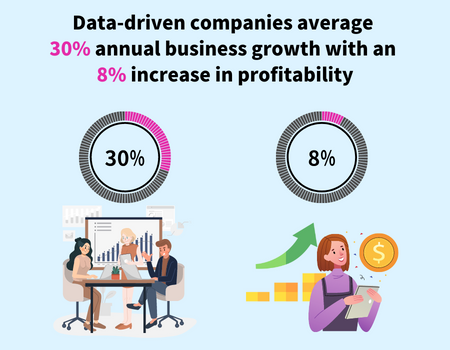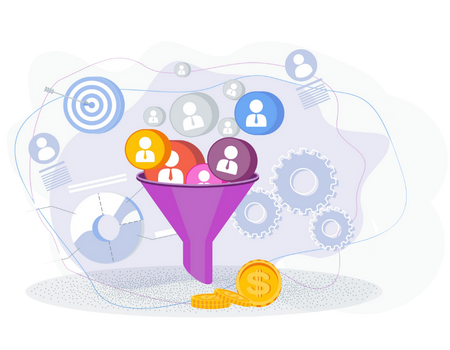How to get started with HR analytics
Want to know the best way to diagnose and deal with the most pressing business problems plaguing your organization? It’s not to hire more staff or throw more money at them. Instead, your best bet is to leverage workforce analytics to pinpoint the areas of your business in need of improvement.
By analyzing your HR data, you can discover if you have issues with employee engagement, retention, communication, and more. From there, you can go about brainstorming & implementing solutions, all while keeping an eye on your HR metrics to find out what works and what doesn’t.
Data analytics are nothing new to most departments, especially sales & marketing, but HR analytics have been less common until recently. The advent of AI algorithms capable of processing big data in recent years has made HR departments take notice.
Since human resources departments already gather tons of employee data through spreadsheets, personnel files, HRIS (human resources information system), and CRM tools – why not use them to improve your overall employee experience and performance?
After all, it’s been proven that data-driven companies average 30% annual business growth with an 8% increase in profitability – so you have every incentive to learn how to get started with HR analytics.
Stay tuned to find out how you can set up HR analytics at your company to uncover actionable insights that will help you achieve your business goals.
The 4 Different Types of HR Analytics
 HR analytics, also called people analytics, refers to monitoring and analyzing data sources related to your organization’s employees and teams.
HR analytics, also called people analytics, refers to monitoring and analyzing data sources related to your organization’s employees and teams.
These data sets can relate to employee turnover, demographics, employee retention, engagement, absenteeism, and other factors related to human capital.
Department heads can use HR analytics tools to monitor their people data, such as Hibob HRIS and ADP Workforce Now, to name a few.
Why should you bother with HR data analytics?
You should because they’ll guide your decision-making and business strategy moving forward. With the power of HR analytics by your side, you can make more informed decisions related to acquiring talent, employee experience, and productivity – which will help you achieve your desired business outcomes.
As stated before, companies that make data-driven decisions are more profitable and grow faster than ones that do not – which is why it’s worth learning how to get started with HR analytics.
First, it’s crucial to understand the 4 different types of HR analytics to know which you need to use the most at your organization.
Descriptive Analytics
You can think of descriptive analytics as a summary of historical HR data that can help you identify trends and patterns.
As the name implies, this type of data analysis describes a collection of data sources. In other words, descriptive analytics don’t do anything to diagnose or fix issues; they simply summarize the findings from the data.
Using descriptive analytics, you may uncover patterns or trends related to employee performance, turnover rate, retention, attrition rates, and more.
Predictive Analytics
Besides identifying your current issues & trends, you can also use the analytics process to forecast the future.
By analyzing a combination of current and historical data, you can anticipate future business outcomes with startling accuracy. Predictive analytics involves statistical techniques like machine learning algorithms and data mining to piece together an accurate picture of the future.
Diagnostic Analytics
This type of data analysis involves discovering the underlying cause for problems exhibited by descriptive analytics.
Once you identify the root cause of the issue, you can go about brainstorming solutions, which brings us to the next type of analytics.
Prescriptive Analytics
At this stage, you’ve identified the most pressing patterns in your data, and you know which problems you need to focus on.
As such, prescriptive analytics provide a ‘prescription’ for how to deal with the issues you’ve already uncovered. These types of analytics are especially valuable for businesses that have ‘busy seasons,’ such as during the summer or around Christmas.
How to Implement HR Analytics in Your Organization
Since you know a bit more about HR analytics and why they’re beneficial, it’s time to learn how to include them in your business processes.
That means finding the right HR systems & analytical tools that you need to achieve your primary goals.
To get started with your analytics project, the first step is to identify the HR metrics that you need to track the most. From there, you’ll want to centralize your data in one location and then find ways to visualize your data to ensure it’s easy to digest.
Once that’s done, you’ll need to train your HR team on the new process, as well as create initiatives for improving your analytics in the future.
That’s a lot to process, so let’s take a closer look at each step.
Identify the Key Metrics You Need to Track
Before you do anything else, you need to know which metrics are the most pressing for your organization’s current needs.
What do we mean by that?
Well, you don’t want to waste time and resources tracking metrics that are A-OK. For instance, let’s say that you focus on tracking your employee retention data, even though your employees stay an average of 5+ years with the company, which is excellent.
At the same time, you choose not to track employee performance data, even though faltering employee performances are the primary issue holding back your organization.
As you can see, paying attention to the wrong metrics can actually hurt your business, which is why it’s so crucial to uncover the metrics you DO need to track.
To find the metrics that matter most to your organization, you need to ask yourself a few questions.
What are the most significant challenges currently facing your organization? What questions are left unanswered in regard to your employee’s performance and well-being?
These questions will help you identify the metrics and data sources you need to focus on the most, such as performance management. Once you have a solid grasp on what you need to track, you can move on to the next step.
Centralize Your Data in One Spot

Ideally, you should have a central HR dashboard that contains all the data you need to analyze.
Why is that?
It’s because trying to gather & analyze data from more than one location is a huge inconvenience and can lead to costly mistakes.
With all your important people data in one spot, your data scientists will have a much easier time making sense of it all.
If your HR department is like most, the chances are high that you’re already gathering a ton of data from paper files, CRMs, HRIS systems, and Excel spreadsheets. The data you need is already there, and all you have to do is centralize it to stay organized. To do so, there are plenty of cloud-based human resource management tools that make this process a breeze.
Use Data Visualization
Once you have your data consolidated, you need to find ways to make it jump off the page.
After all, a collection of numbers & figures locked in a spreadsheet won’t tell much of a story to your HR professionals. Most people are visual learners (approximately 65%), which means they need to be able to visualize your data sets through charts, diagrams, and infographics.
The more visual you can make your data, the easier it will be for you and your team to make sense of it.
Again, there are cloud-based HR analytics tools that have extensive data visualization features, which will allow you to make data-driven decisions in real time.
Train Your Team
Once you have decided on which metrics to track, have a centralized location for your data, and implemented data visualization techniques – it’s time to train your team on all these new processes.
You’ll need to identify the key stakeholders that will need to access your analytics, such as HR leaders, executives, and HR managers.
If your in-house team doesn’t have any time to devote to HR analytics, you can consider onboarding data scientists to analyze your data.
Refine Your Analytics Process
At this point, you’ve hit the ground running with analyzing your people data. Yet, you’ve only just begun, and there are always ways to refine your methods.
After keeping tabs on the process for a while, you’re bound to uncover loopholes, inefficiencies, and mistakes to correct. You’ll refine your process to near perfection as long as you do what’s necessary to solve each recurrent problem.
Final Thoughts: How to Get Started with HR Analytics
Issues like high employee turnover and low engagement can cripple organizations, which is why it’s so crucial to pay attention to HR data.
By now, you should better understand how to get started with HR analytics at your company to avoid such issues.
If you focus on the right metrics to track and train your team on analyzing your data sets, nothing will stand in your way from achieving all your business goals.
What HR analytical tools do you use at your organization? Let me know in the comments.






